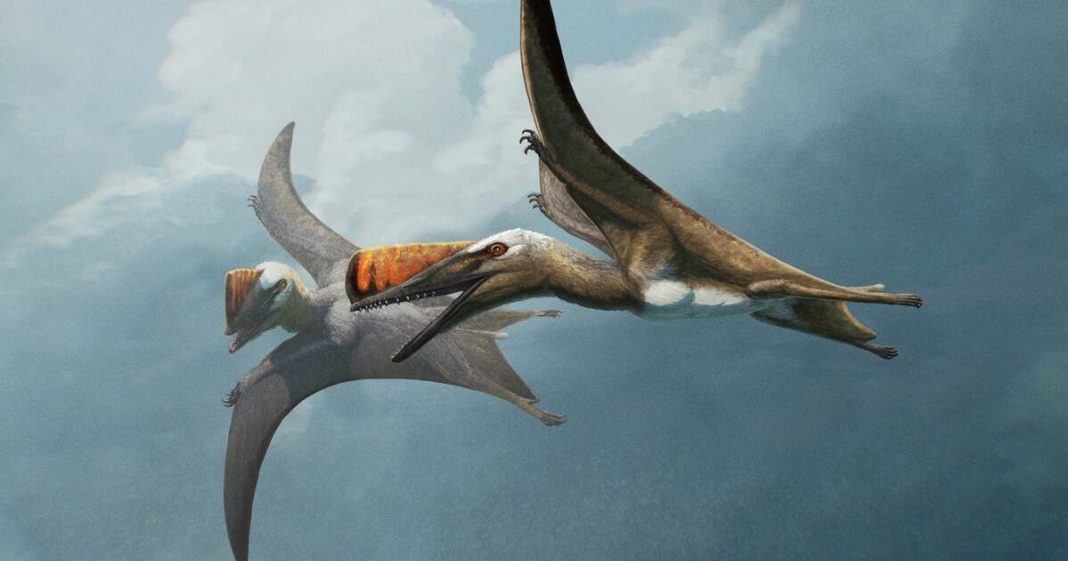Paleontologists have unveiled the fossilized remains of a newly identified pterosaur species, Skiphosoura bavarica. Unearthed in Bavaria, Germany, this 147-million-year-old specimen bridges a crucial evolutionary gap between early and later pterosaurs, providing a clearer picture of how these remarkable creatures evolved to dominate prehistoric skies.
Transitional Species from the Jurassic Era
The discovery of Skiphosoura bavarica sheds light on a pivotal phase in pterosaur evolution. Living during the late Jurassic Period, this species displays a mix of anatomical features found in early long-tailed pterosaurs and the later short-tailed giants of the Cretaceous, such as Quetzalcoatlus. Its name, meaning “sword tail from Bavaria,” reflects its most distinctive physical feature: a short, stiff, pointed tail.
Read More: Astronomers unveil mysterious ‘Neptunian Ridge’
Dr. David Hone, a paleontologist at Queen Mary University of London and lead author of the study published in Current Biology, described the find as “of huge importance.” Hone noted that Skiphosoura helps refine the pterosaur family tree by clarifying how certain evolutionary traits emerged and changed over time.
Preserved in Stunning Detail
What sets Skiphosoura apart from most pterosaur fossils is its exceptional preservation. Found in 2015 in southeastern Germany, the fossil remains nearly complete and three-dimensional, a rarity given the fragility of pterosaur bones. These creatures’ lightweight, hollow bones often collapse or disintegrate during fossilization.
“The skeleton is preserved in incredible detail,” Hone explained, “allowing us to study its anatomy more comprehensively than usual.”
The creature’s 10-inch (25 cm) skull featured a bony crest that likely extended into a colorful soft-tissue structure. This crest may have played a role in display or species recognition. Sharp, elongated teeth suggest it preyed on small animals like lizards, mammals, insects, and possibly fish, likely hunting in forested environments.
Bridging Evolutionary Gaps
Pterosaurs, which first appeared during the Triassic Period roughly 227 million years ago, are divided into two major groups: early non-pterodactyloids and the later pterodactyloids. Early pterosaurs had short heads, compact necks, long tails, and elongated fifth toes. In contrast, pterodactyloids evolved elongated heads, long necks, shortened tails, and more advanced wing structures, eventually giving rise to giants with wingspans up to 32 feet.
The discovery of Skiphosoura positions it as an evolutionary bridge between the darwinopterans—a transitional group identified in the 2010s—and the later pterodactyloids. It demonstrates that key traits, like a larger head and longer neck, developed before other changes, such as shorter tails and advanced wings.
A Scottish Connection
The fossil of another transitional species, Dearc sgiathanach, discovered in Scotland, has further clarified the sequence of evolutionary adaptations in pterosaurs. Together, these discoveries reveal how early pterosaurs gradually evolved into the giant flyers of the Cretaceous, providing invaluable insights into their adaptation and diversification.
Read More: Existence of liquid found on an exoplanet 124 light-years away from …
Besides its evolutionary significance, Skiphosoura highlights the ecological roles pterosaurs played. From inland predators like Skiphosoura to oceanic hunters, they shaped ecosystems before their extinction 66 million years ago alongside the dinosaurs. Adam Fitch of the Field Museum in Chicago emphasized the broader implications: “Pterosaurs like Skiphosoura illustrate how evolution enabled these creatures to thrive across diverse habitats.”














